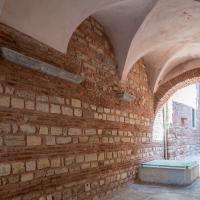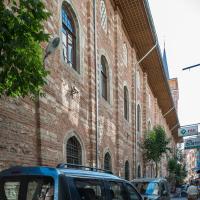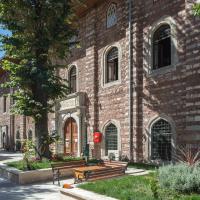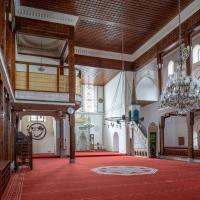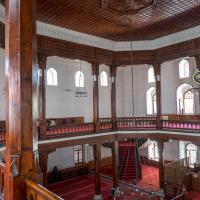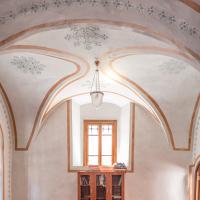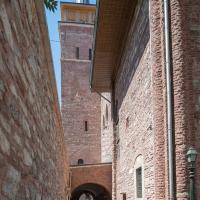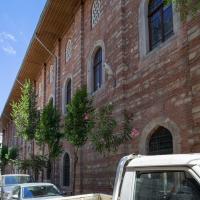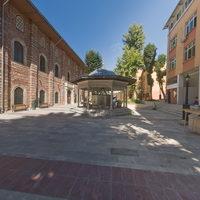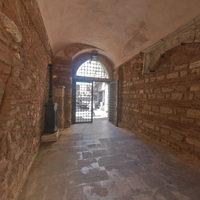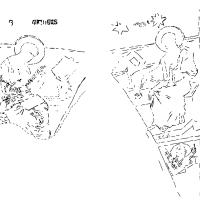San Paolo, San Paolo e Domenico
Unknown
Early 14th century
Description
Arap Camii, the former Latin Church dedicated to Saint Paul and Saint Dominic, as attested in a number of secondary sources, is located in the Galata district, near Karaköy on the northern shore of the Golden Horn (Janin, 1964: 599; Palazzo, 1949: XII). Arap Camii is believed to have been first constructed on the remains of this sixth century church dedicated to Saint Eirene, which defined the borders of the Genoese settlement in Galata on a chyrsobull dated to 1303 (Palazzo, 1949: 49).
The monument’s current name associated to the Arab community has triggered ample scholarly debates about an earlier mosque constructed on the same site during the Arap siege of Constantinople in 717 by Maslama, an emir of the Ommeyad House (Hasluck, 1916: 157-59; Janin, 1964: 599; Müller-Wiener, 1977: 79; Cetinkaya, 2010: 171).
The Latin community of Galata, primarily the Dominicans, possibly undertook the first initiative for the construction of a larger Catholic church by 1260, as implied by the tombstones dated around the same years (Janin, 1964: 599,;D’Allesio, 1936: 83; Belin, 1894: 214). Yet, only in a half century, in 1307, following the expulsion of the Latins from Constantinople under Andronicus II, the property handed over to Guillaume-Bernard who has enlarged the complex (D’Allesio, 1936: 83).
Following the conquest of Constantinople by the Ottomans, a treaty was signed between the Ottomans and la Magnifica Communità of Pera, which has allowed the church to remain in the Latin property until 1475, when the Dominicans are also reported to move to another nearby monastery (Janin, 1964: 600; Palazzo, 1942: 38).
Arap Camii, the first name given to the converted church most likely originates from the relocation of the Moors of Spain in 1492 in this particular region in the new Ottoman capital (Eyice, 1969: 53). For centuries, the mosque has undergone numerous repairs. One of the largest was during the lifetime of the mother of Ahmed III in the seventeenth century, who is believed to have ordered the destruction of the houses that surrounded the mosque. A century later, female sultans’ interests into the mosque continued, and in 1734/5, the plan of the structure was significantly modified by Valide Saliha Sultan, the mother of Mahmud I, who is also credited with the construction of the fountain that is located the northern courtyard (Palazzo, 1949: 3; Janin, 1964: 600; Ayvansarayi, 2001: 427). In 1809, another restoration work associated with the daughter of Mahmut II, which was followed by 1845-5, during the Crimean war was commissioned (Müller-Wiener, 1977: 80). During the restoration works in 1913-16, a number of frescoes were discovered under the badigeon, and the tombstones that long lied dispersed in the garden were finally transferred to the Istanbul Archaeological Museum (Janin, 1964: 600; D’Alessio, 1932: 191). One of the latest restoration projects had been conducted only a couple of years ago by the Pious Foundations of Istanbul, where the fresco decorations of the thirteenth century were revealed again, and respectively recovered by the decision of the High Council of Monuments, Istanbul after their conservation.
VR Tour
Map Location
Bibliography
- Akyürek, Engin, Ayça Tiryaki, Melda Ermiş. Türkiye Arkeolojik Yerleşmelerileri (TAY) Bizans Dönemi Klasörü, C.8.I. (Marmara), (Istanbul, 2007).
- Akyürek, Engin, “Dominican painting in Palaiologan Constantinople: The Frescoes of the Arap Camii (Church of S. Domenico) in Galata,” in Kariye Camii Reconsidered/ Kariye Camii Yeniden. ed. Klein, Holger. A., Ousterhout, R.G., Pitarakis, B. (İstanbul: İstanbul Araştırmaları Enstitüsü, 2011): 327-41.
- Ayvansarayi, Hüseyin bin Ismail, Hadikat-ül Cevami (Istanbul, 1894): II. 30.
- Belin, Alphonse. Histoire de la latinité de Constantinople. 2nd ed. (Paris, 1894).
- Çetinkaya, Haluk. “Arap Camii in Istanbul: Its Architecture and Frescoes,” Anatolia Antiqua XVIII (2010): 169-88.
- D'Alessio, Eugenio, “L'établissement dominicain de Pera (Galata),” Échos d'Orient 35 (1936): 83-86.
- D'Alessio, Eugenio, “Familles Latines de Pera au Temps des Paléologues d' après les inscriptions d'Arap Djami,” Échos d'Orient 35 (1936): 413-420.
- D'Alessio, Eugenio, Le Pietre Sepolcrali di Arap Giami, Antica Chiesa di S.Paolo Galata (Cenova, 1942).
- Ebersolt, Jean, Mission archéologique de Constantinople (Paris, 1921): 38-44.
- Esad, Arseven Celal, Eski Galata ve Binaları (Istanbul, 1911).
- Eyice, Semavi, “Arab Camii,” Istanbul Ansiklopedisi, V.III (Istanbul, 1959): 936-947.
- Giordani, Fabrizio, “L'Arap Cami o antica chiesa di S. Paolo a Galata,” Opus 4 (1995): 267-292.
- Hasluck, Frederick William, “The Mosques of the Arabs in Constantinople,” The Annual of the British School at Athens 22 (1916-1918): 157-74.
- Janin, Raymond, La Géographie Ecclésiastique de L'empire Byzantin, Première Partie: Le siège de Constantinople et le patriarcat oecuménique, Les Églises et les monastères (Paris, 1969): 598-600.
- Loenertz, Raymond, “Les Établissements Dominicains de Péra- Constantinople,” Échos d'Orient 34 (1935): 332-49.
- Mitler, Louis, “The Genoese in Galata: 1453-1682,” International Journal of Middle East Studies 10 (1979): 71-91.
- Müller-Wiener, Wolfgang, Bildlexikon Zur Topographie Istanbuls. (Tübingen, 1977).
- Nomidis, M.I., Schneider, Alphonse Maria, Galata. Topographisch-Archäologischer Plan (Istanbul, 1944).
- Palazzo, Benedetto, L'Arap Djami ou Église Saint-Paul à Galata (Istanbul, 1949).
- Westphalen, Stephan, “Pittori Greci Nella Chiesa Dominicana Dei Genovesi a Pera (Arap Camii),” in Intorno al Sacro Volto. Genova, Bisanzio e il Mediterraneo (secoli XI - XIV) eds. by A.-R.; Dufour Bozzo Calderoni Masetti, C. and Gerhard Wolf (Venice, 2007): 51-62.
- Westphalen, Stephan, “Die Dominikanerkirche der Genuesen von Pera (Arap Camii). Griechische Maler- Lateinische Auftraggeber,” in Ulrike Wulff-Rheidt and Felix Pirson (eds.), Austausch und Inspiration Kulturkontakt als Impuls architektonischer Innovation (Diskussion zur Archaologischen Bauforschung 9) (Mainz, 2008): 276-91.










